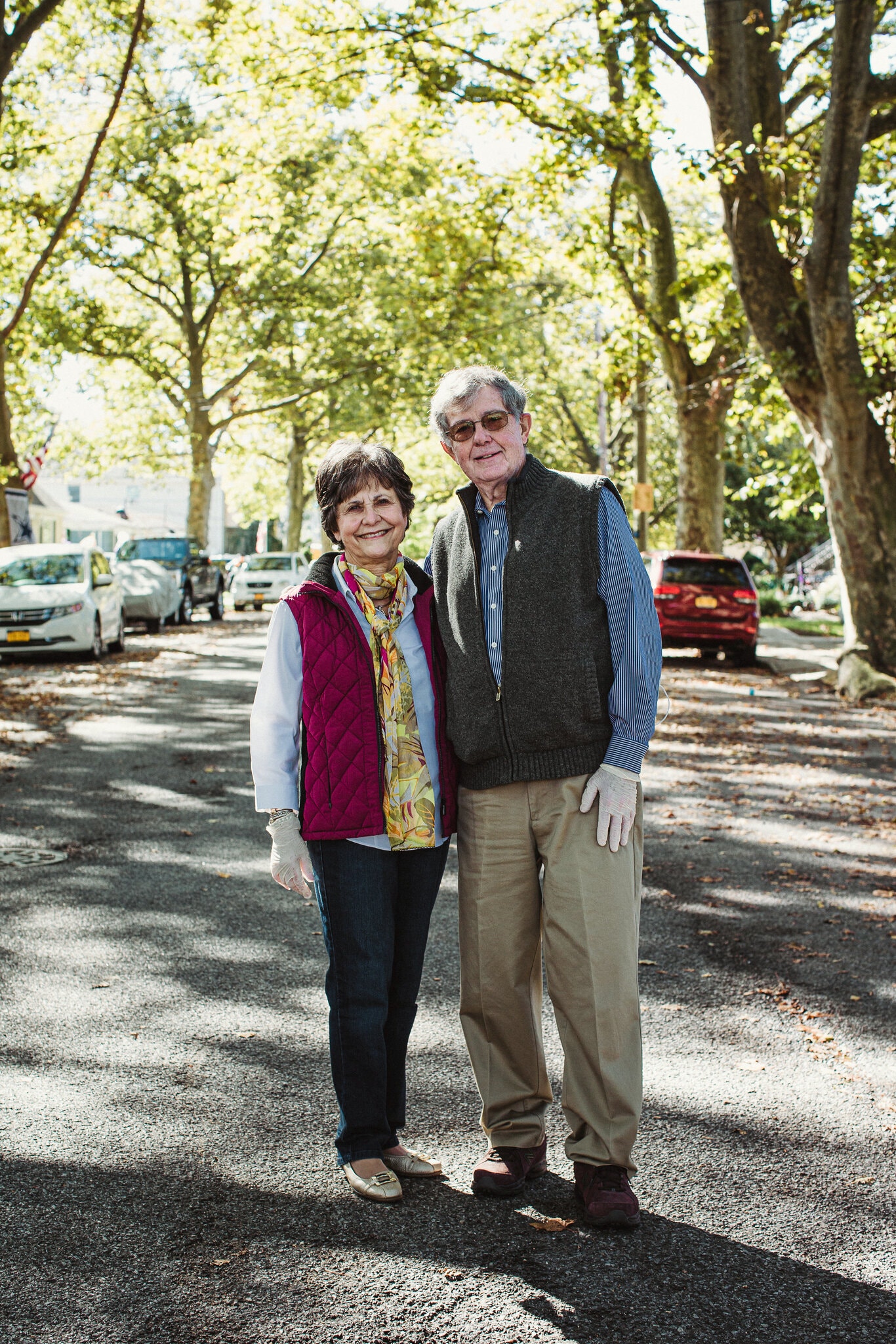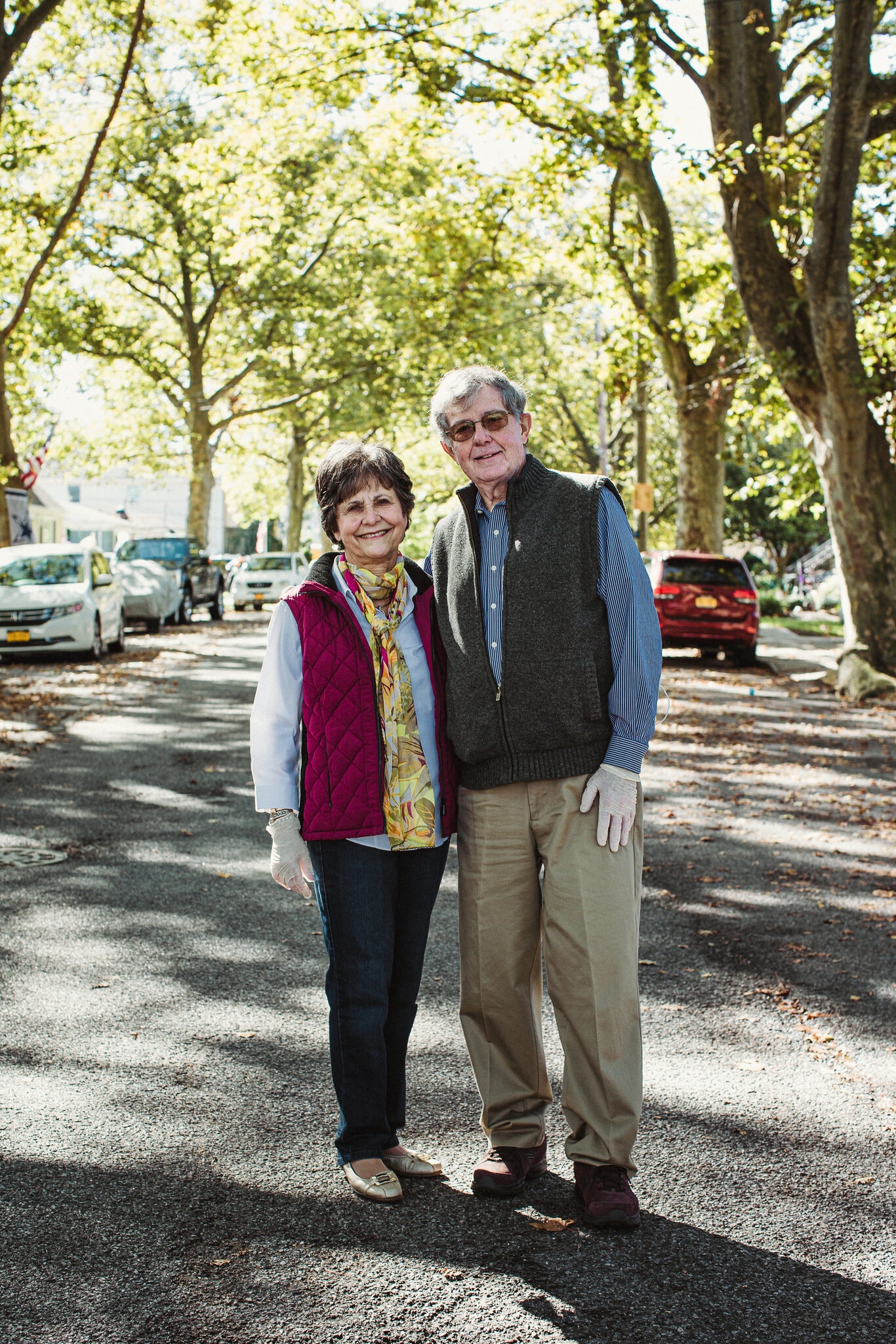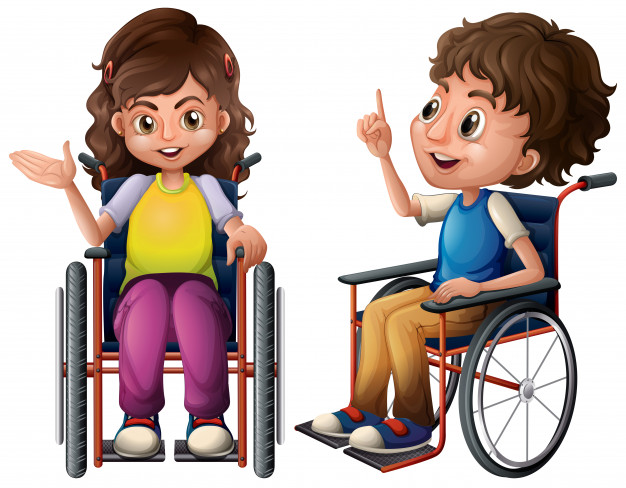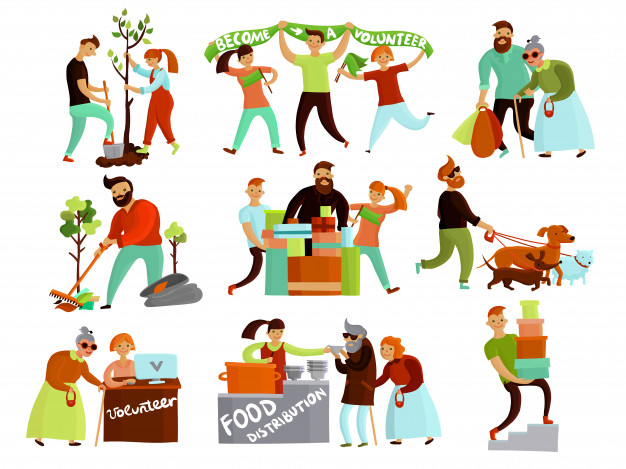Bài học cùng chủ đề
Báo cáo học liệu
Mua học liệu
Mua học liệu:
-
Số dư ví của bạn: 0 coin - 0 Xu
-
Nếu mua học liệu này bạn sẽ bị trừ: 2 coin\Xu
Để nhận Coin\Xu, bạn có thể:

Practice SVIP
Bonnie and Ned Rogers, both 74, have also spent their retirement helping others. They were born and raised on Staten Island, met in college on a blind date and have been married for 52 years. In 2000, after retiring from the telecom industry, Ms. Rogers saw an ad in her church newsletter for the Retired and Senior Volunteer Program, run by Community Service Society, another organization supported by The Fund.
“I wasn't quite old enough at the time to join,” Ms. Rogers explains, “but they let me be a sort of welcome volunteer.”
Two years later, when a friend and fellow volunteer passed away, the program asked if Ms. Rogers could take over his route for Meals on Wheels, a food assistance program for seniors. Mr. Rogers joined her after he retired in 2004, and they've been working it as a team ever since.
“You have a route with dedicated people, and over time you establish a relationship with them,” Mr. Rogers said. “A lot of the clients are homebound, and they look forward every day to having this interaction with somebody.”
Those relationships were brought to an abrupt halt by the pandemic. In March, the service shifted to providing weekly deliveries of frozen food instead of prepared food five days a week, and volunteers like Mr. and Ms. Rogers were put on the bench.
“We really missed it,” Mr. Rogers said. “While volunteering, we give back, but there's a lot we receive from doing it, too. It's not true altruism. It gives us a reason for being.”
In May, Mr. and Ms. Rogers returned to their Meals on Wheels route as community organizations found ways to adapt.
The couple worried about those whom they hadn't seen in weeks. But on their first day back, they were pleased to see many familiar faces. “The thank you's, the smiles - even with masks on - were wonderful,” Ms. Rogers said.
Retrieved from "Where Covid Left Holes, Volunteers Stepped In" - The New York Times
Read and answer the question.
After retiring, which program has Ms. Rogers become a welcome volunteer for?
Bonnie and Ned Rogers, both 74, have also spent their retirement helping others. They were born and raised on Staten Island, met in college on a blind date and have been married for 52 years. In 2000, after retiring from the telecom industry, Ms. Rogers saw an ad in her church newsletter for the Retired and Senior Volunteer Program, run by Community Service Society, another organization supported by The Fund.
“I wasn't quite old enough at the time to join,” Ms. Rogers explains, “but they let me be a sort of welcome volunteer.”
Two years later, when a friend and fellow volunteer passed away, the program asked if Ms. Rogers could take over his route for Meals on Wheels, a food assistance program for seniors. Mr. Rogers joined her after he retired in 2004, and they've been working it as a team ever since.
“You have a route with dedicated people, and over time you establish a relationship with them,” Mr. Rogers said. “A lot of the clients are homebound, and they look forward every day to having this interaction with somebody.”
Those relationships were brought to an abrupt halt by the pandemic. In March, the service shifted to providing weekly deliveries of frozen food instead of prepared food five days a week, and volunteers like Mr. and Ms. Rogers were put on the bench.
“We really missed it,” Mr. Rogers said. “While volunteering, we give back, but there's a lot we receive from doing it, too. It's not true altruism. It gives us a reason for being.”
In May, Mr. and Ms. Rogers returned to their Meals on Wheels route as community organizations found ways to adapt.
The couple worried about those whom they hadn't seen in weeks. But on their first day back, they were pleased to see many familiar faces. “The thank you's, the smiles - even with masks on - were wonderful,” Ms. Rogers said.
Retrieved from "Where Covid Left Holes, Volunteers Stepped In" - The New York Times
Read and answer the question.
In 2004, which program have Mr. and Ms. Rogers been working for together?

Bonnie and Ned Rogers, both 74, have also spent their retirement helping others. They were born and raised on Staten Island, met in college on a blind date and have been married for 52 years. In 2000, after retiring from the telecom industry, Ms. Rogers saw an ad in her church newsletter for the Retired and Senior Volunteer Program, run by Community Service Society, another organization supported by The Fund.
“I wasn't quite old enough at the time to join,” Ms. Rogers explains, “but they let me be a sort of welcome volunteer.”
Two years later, when a friend and fellow volunteer passed away, the program asked if Ms. Rogers could take over his route for Meals on Wheels, a food assistance program for seniors. Mr. Rogers joined her after he retired in 2004, and they've been working it as a team ever since.
“You have a route with dedicated people, and over time you establish a relationship with them,” Mr. Rogers said. “A lot of the clients are homebound, and they look forward every day to having this interaction with somebody.”
Those relationships were brought to an abrupt halt by the pandemic. In March, the service shifted to providing weekly deliveries of frozen food instead of prepared food five days a week, and volunteers like Mr. and Ms. Rogers were put on the bench.
“We really missed it,” Mr. Rogers said. “While volunteering, we give back, but there's a lot we receive from doing it, too. It's not true altruism. It gives us a reason for being.”
In May, Mr. and Ms. Rogers returned to their Meals on Wheels route as community organizations found ways to adapt.
The couple worried about those whom they hadn't seen in weeks. But on their first day back, they were pleased to see many familiar faces. “The thank you's, the smiles - even with masks on - were wonderful,” Ms. Rogers said.
Retrieved from "Where Covid Left Holes, Volunteers Stepped In" - The New York Times
Read and answer the question.
What does "pass away" mean?
 Bonnie and Ned Rogers, both 74, have also spent their retirement helping others. They were born and raised on Staten Island, met in college on a blind date and have been married for 52 years. In 2000, after retiring from the telecom industry, Ms. Rogers saw an ad in her church newsletter for the Retired and Senior Volunteer Program, run by Community Service Society, another organization supported by The Fund.
Bonnie and Ned Rogers, both 74, have also spent their retirement helping others. They were born and raised on Staten Island, met in college on a blind date and have been married for 52 years. In 2000, after retiring from the telecom industry, Ms. Rogers saw an ad in her church newsletter for the Retired and Senior Volunteer Program, run by Community Service Society, another organization supported by The Fund.
“I wasn't quite old enough at the time to join,” Ms. Rogers explains, “but they let me be a sort of welcome volunteer.”
Two years later, when a friend and fellow volunteer passed away, the program asked if Ms. Rogers could take over his route for Meals on Wheels, a food assistance program for seniors. Mr. Rogers joined her after he retired in 2004, and they've been working it as a team ever since.
“You have a route with dedicated people, and over time you establish a relationship with them,” Mr. Rogers said. “A lot of the clients are homebound, and they look forward every day to having this interaction with somebody.”
Those relationships were brought to an abrupt halt by the pandemic. In March, the service shifted to providing weekly deliveries of frozen food instead of prepared food five days a week, and volunteers like Mr. and Ms. Rogers were put on the bench.
“We really missed it,” Mr. Rogers said. “While volunteering, we give back, but there's a lot we receive from doing it, too. It's not true altruism. It gives us a reason for being.”
In May, Mr. and Ms. Rogers returned to their Meals on Wheels route as community organizations found ways to adapt.
The couple worried about those whom they hadn't seen in weeks. But on their first day back, they were pleased to see many familiar faces. “The thank you's, the smiles - even with masks on - were wonderful,” Ms. Rogers said.
Retrieved from "Where Covid Left Holes, Volunteers Stepped In" - The New York Times
Read and answer the question.
What is the synonym of "altruism"?
 Bonnie and Ned Rogers, both 74, have also spent their retirement helping others. They were born and raised on Staten Island, met in college on a blind date and have been married for 52 years. In 2000, after retiring from the telecom industry, Ms. Rogers saw an ad in her church newsletter for the Retired and Senior Volunteer Program, run by Community Service Society, another organization supported by The Fund.
Bonnie and Ned Rogers, both 74, have also spent their retirement helping others. They were born and raised on Staten Island, met in college on a blind date and have been married for 52 years. In 2000, after retiring from the telecom industry, Ms. Rogers saw an ad in her church newsletter for the Retired and Senior Volunteer Program, run by Community Service Society, another organization supported by The Fund.
“I wasn't quite old enough at the time to join,” Ms. Rogers explains, “but they let me be a sort of welcome volunteer.”
Two years later, when a friend and fellow volunteer passed away, the program asked if Ms. Rogers could take over his route for Meals on Wheels, a food assistance program for seniors. Mr. Rogers joined her after he retired in 2004, and they've been working it as a team ever since.
“You have a route with dedicated people, and over time you establish a relationship with them,” Mr. Rogers said. “A lot of the clients are homebound, and they look forward every day to having this interaction with somebody.”
Those relationships were brought to an abrupt halt by the pandemic. In March, the service shifted to providing weekly deliveries of frozen food instead of prepared food five days a week, and volunteers like Mr. and Ms. Rogers were put on the bench.
“We really missed it,” Mr. Rogers said. “While volunteering, we give back, but there's a lot we receive from doing it, too. It's not true altruism. It gives us a reason for being.”
In May, Mr. and Ms. Rogers returned to their Meals on Wheels route as community organizations found ways to adapt.
The couple worried about those whom they hadn't seen in weeks. But on their first day back, they were pleased to see many familiar faces. “The thank you's, the smiles - even with masks on - were wonderful,” Ms. Rogers said.
Retrieved from "Where Covid Left Holes, Volunteers Stepped In" - The New York Times
Read and answer the question.
Did Mr. and Ms. Rogers return to their Meals on Wheels route?
 Bonnie and Ned Rogers, both 74, have also spent their retirement helping others. They were born and raised on Staten Island, met in college on a blind date and have been married for 52 years. In 2000, after retiring from the telecom industry, Ms. Rogers saw an ad in her church newsletter for the Retired and Senior Volunteer Program, run by Community Service Society, another organization supported by The Fund.
Bonnie and Ned Rogers, both 74, have also spent their retirement helping others. They were born and raised on Staten Island, met in college on a blind date and have been married for 52 years. In 2000, after retiring from the telecom industry, Ms. Rogers saw an ad in her church newsletter for the Retired and Senior Volunteer Program, run by Community Service Society, another organization supported by The Fund.
“I wasn't quite old enough at the time to join,” Ms. Rogers explains, “but they let me be a sort of welcome volunteer.”
Two years later, when a friend and fellow volunteer passed away, the program asked if Ms. Rogers could take over his route for Meals on Wheels, a food assistance program for seniors. Mr. Rogers joined her after he retired in 2004, and they've been working it as a team ever since.
“You have a route with dedicated people, and over time you establish a relationship with them,” Mr. Rogers said. “A lot of the clients are homebound, and they look forward every day to having this interaction with somebody.”
Those relationships were brought to an abrupt halt by the pandemic. In March, the service shifted to providing weekly deliveries of frozen food instead of prepared food five days a week, and volunteers like Mr. and Ms. Rogers were put on the bench.
“We really missed it,” Mr. Rogers said. “While volunteering, we give back, but there's a lot we receive from doing it, too. It's not true altruism. It gives us a reason for being.”
In May, Mr. and Ms. Rogers returned to their Meals on Wheels route as community organizations found ways to adapt.
The couple worried about those whom they hadn't seen in weeks. But on their first day back, they were pleased to see many familiar faces. “The thank you's, the smiles - even with masks on - were wonderful,” Ms. Rogers said.
Retrieved from "Where Covid Left Holes, Volunteers Stepped In" - The New York Times
Read the passage again and tick True or False.
(Nhấp vào dòng để chọn đúng / sai)| Ms. Rogers has taken part in the program run by Community Service Society. |
|
| In March, Mr. and Ms. Rogers developed the service very well. |
|
| Some of the clients of the organization are only at home and lonely. |
|
| Bonnie and Ned Rogers are both 74 years old. |
|
| Many familiar people didn't realize the couple after they came back in May. |
|
Read and choose the best answer to complete the passage.
Mr. Charlie and some
- voluntary
- volunteers
- volunteer
- on
- into
- with
- divides
- divide
- divided
- Though
- And
- But
- yard
- dump
- place
Read and fill in the blanks with the correct form of the words.
On January 17th, 1995, a powerful earthquake hit the city of Kobe, Japan. Many buildings (burn) or collapsed.
Soon after the earthquake, people in Kobe (begin) working together to save their city. Neighbours pulled each other out of collapsed buildings. Ordinary people (put) out fires even before the fire trucks (arrive) . Volunteers in Kobe (organize) themselves into teams. They worked out a system to send help to the place where it was needed. Some people (bring) food, water, clothes to (differ) parts of city. Some volunteers (take) care of children who had lost their parents. Teams of (voluntary) from outside Japan helped, too.
Today, Kobe has been rebuilt. But people there still remember the outpouring of support they (receive) from all over the world back in 1995.
International Young Pioneer Organisation
We send young people of different nationalities on expeditions around the world. Our volunteers get the chance to work with local people to learn about different cultures, and to live in an exciting environment. This often helps them to become more confident and responsible people.
The expeditions
There are ten expeditions every year. Each expedition lasts for ten weeks and takes 150 volunteers. They go to countries such as Chile, Namibia, Mongolia and Viet Nam. Some of our volunteers work with local people to provide important facilities, for example, building schools. Others work in national parks or help scientists do environmental research.
The volunteers
These young adventurous people come from all over the world. To become a volunteer you have to be between 17 and 25; you have to speak English quite well and you also have to be enthusiastic, flexible and hard-working members of a team.
Read the passage and choose the correct answer.
1. Who goes on International Young Pioneer Organisation expeditions?
International Young Pioneer Organisation
We send young people of different nationalities on expeditions around the world. Our volunteers get the chance to work with local people to learn about different cultures, and to live in an exciting environment. This often helps them to become more confident and responsible people.
The expeditions
There are ten expeditions every year. Each expedition lasts for ten weeks and takes 150 volunteers. They go to countries such as Chile, Namibia, Mongolia and Viet Nam. Some of our volunteers work with local people to provide important facilities, for example, building schools. Others work in national parks or help scientists do environmental research.
The volunteers
These young adventurous people come from all over the world. To become a volunteer you have to be between 17 and 25; you have to speak English quite well and you also have to be enthusiastic, flexible and hard-working members of a team.
Read and choose the best answer.
2. How many expeditions are there every year?
International Young Pioneer Organisation
We send young people of different nationalities on expeditions around the world. Our volunteers get the chance to work with local people to learn about different cultures, and to live in an exciting environment. This often helps them to become more confident and responsible people.
The expeditions
There are ten expeditions every year. Each expedition lasts for ten weeks and takes 150 volunteers. They go to countries such as Chile, Namibia, Mongolia and Viet Nam. Some of our volunteers work with local people to provide important facilities, for example, building schools. Others work in national parks or help scientists do environmental research.
The volunteers
These young adventurous people come from all over the world. To become a volunteer you have to be between 17 and 25; you have to speak English quite well and you also have to be enthusiastic, flexible and hard-working members of a team.
Read and choose the best answer.
3. How long does each expedition last?
International Young Pioneer Organisation
We send young people of different nationalities on expeditions around the world. Our volunteers get the chance to work with local people to learn about different cultures, and to live in an exciting environment. This often helps them to become more confident and responsible people.
The expeditions
There are ten expeditions every year. Each expedition lasts for ten weeks and takes 150 volunteers. They go to countries such as Chile, Namibia, Mongolia and Viet Nam. Some of our volunteers work with local people to provide important facilities, for example, building schools. Others work in national parks or help scientists do environmental research.
The volunteers
These young adventurous people come from all over the world. To become a volunteer you have to be between 17 and 25; you have to speak English quite well and you also have to be enthusiastic, flexible and hard-working members of a team.
Read and choose the best answer.
4. Which of the following activites the volunteers does NOT do?
International Young Pioneer Organisation
We send young people of different nationalities on expeditions around the world. Our volunteers get the chance to work with local people to learn about different cultures, and to live in an exciting environment. This often helps them to become more confident and responsible people.
The expeditions
There are ten expeditions every year. Each expedition lasts for ten weeks and takes 150 volunteers. They go to countries such as Chile, Namibia, Mongolia and Viet Nam. Some of our volunteers work with local people to provide important facilities, for example, building schools. Others work in national parks or help scientists do environmental research.
The volunteers
These young adventurous people come from all over the world. To become a volunteer you have to be between 17 and 25; you have to speak English quite well and you also have to be enthusiastic, flexible and hard-working members of a team.
Read and choose the best answer.
5. Which language must people know to become a volunteer?
International Young Pioneer Organisation
We send young people of different nationalities on expeditions around the world. Our volunteers get the chance to work with local people to learn about different cultures, and to live in an exciting environment. This often helps them to become more confident and responsible people.
The expeditions
There are ten expeditions every year. Each expedition lasts for ten weeks and takes 150 volunteers. They go to countries such as Chile, Namibia, Mongolia and Viet Nam. Some of our volunteers work with local people to provide important facilities, for example, building schools. Others work in national parks or help scientists do environmental research.
The volunteers
These young adventurous people come from all over the world. To become a volunteer you have to be between 17 and 25; you have to speak English quite well and you also have to be enthusiastic, flexible and hard-working members of a team.
Read and choose the best answers.
6. Which characters do volunteers need to become a volunteer for this organisation?
Look at the problem and suggest some volunteer works for solution.

Bài làm:
Reply to the questions.

Why should we do volunteer works?

Bạn có thể đăng câu hỏi về bài học này ở đây
